
Guido Reni was an Italian painter of the Baroque period, although his works showed a classical manner, similar to Simon Vouet, Nicolas Poussin, and Philippe de Champaigne. He painted primarily religious works, but also mythological and allegorical subjects. Active in Rome, Naples, and his native Bologna, he became the dominant figure in the Bolognese School that emerged under the influence of the Carracci.

Belisario Corenzio was a Greek-Italian painter, active in Venice and Naples. He is one of few Greek painters that did not belong to the Cretan Renaissance like his contemporaries of the time. He escaped the maniera greca completely. He adopted the Venetian style. Other similar Greek painters were Marco Basaiti, Ioannis Permeniates, Antonio Vassilacchi and El Greco. He was sometimes referred to as Il Greco. His teacher was prominent Venetian painter Tintoretto. In 1590, at age 32 Corenzio settled in Naples. Corenzio was influenced by Cavalier d'Arpino. He continued to flourish in the region. His apprentices included: Luigi Rodriguez, Andrea di Leone, Onofrio De Lione and Massimo Stanzione. Corenzio painted many frescos that survived today. Some of his works are in the Church of San Severino and Certosa di San Martino. His style resembles Caravaggio. An Italian legend in Naples exists involving Corenzio, Spanish painter Jusepe de Ribera, and Battistello Caracciolo. They were referred to as the Cabal of Naples. The three painters were rumored to have poisoned their competition for painting contracts. The rumors lack documented evidence. The three painters were very popular in Naples. Corenzio frescoed the Crypt that holds the remains of Matthew the Apostle at Salerno Cathedral and it depicts scenes from the Gospel of Matthew. Corenzio was one of the most celebrated fresco painters in Naples during his time. His drawings can be found all over the world namely at the Metropolitan Museum, Museo di Capodimonte and Louvre. More recently, his life and work was studied by the Greek art historian Panayotis K. Ioannou in a comprehensive monograph.

The Adoration of the Shepherds is an episode in the story of Jesus's nativity in which shepherds are near witnesses to his birth in Bethlehem, arriving soon after he is actually born. It is recounted, or at least implied, in the Gospel of Luke and follows on from the annunciation to the shepherds, in which the shepherds are summoned by an angel to the scene of the birth. Like the episode preceding it, the adoration is a common subject in art, where it is often combined with the Adoration of the Magi. In such cases it is typically just referred to by the latter title.

Giovanni Lanfranco was an Italian painter of the Baroque period.

The Denial of Saint Peter(La Negazione di Pietro) is a painting finished around 1610 by the Italian painter Caravaggio. It depicts Peter denying Jesus after Jesus was arrested. The painting is housed in the Metropolitan Museum of Art in New York City.

The Nativity is a painting finished around 1529–1530 by the Italian painter Antonio da Correggio. It is housed in the Gemäldegalerie Alte Meister, Dresden.
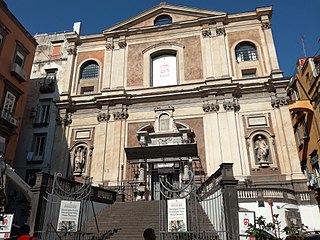
Santa Maria Donnregina Nuova is a church in central Naples, Italy. It is called Nuova ("new") to distinguish it from the older Angevin church of Santa Maria Donna Regina Vecchia.

Massimo Stanzione was an Italian Baroque painter, mainly active in Naples, where he and his rival Jusepe de Ribera dominated the painting scene for several decades. He was primarily a painter of altarpieces, working in both oils and fresco. His main subject matter was biblical scenes. He also painted portraits and mythological subjects. He had many pupils and followers as his rich color and idealized naturalism had a large influence on other local artists, such as Francesco Solimena. In 1621 Pope Gregory XV gave him the title of Knight of the Golden Spur and Pope Urban VIII made him a knight of St. John around 1624 and a knight of the Order of Christ in 1627. From then on, he liked to sign his works as "EQUES MAXIMUS".
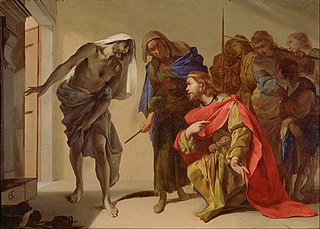
Bernardo Cavallino (1616–1656) was an Italian painter and draughtsman. He is regarded as one of the most original painters active in Naples during the first half of the 17th century.

Andrea Vaccaro was an Italian painter of the Baroque period. Vaccaro was in his time one of the most successful painters in Naples, a city then under Spanish rule. Very successful and valued in his lifetime, Vaccaro and his workshop produced many religious works for local patrons as well as for export to Spanish religious orders and noble patrons. He was initially influenced by Caravaggio, in particular in his chiaroscuro and the naturalistic rendering of his figures.

Saint Agnes is an oil-on-canvas painting executed c. 1635–1640 by the Italian Baroque painter Massimo Stanzione. It is now in the National Art Museum of Catalonia.

David with the Head of Goliath is a painting by Italian Baroque artist Massimo Stanzione, created c. 1642–1643. It is now in the San Diego Museum of Art.

The Basilica of San Pietro ad Aram is a Baroque-style, Roman Catholic church in Naples, Italy. It is located about a block from the church of the Santissima Annunziata on Corso Umberto I.

The Royal Chapel of the Treasure of St. Januarius, or the Reale cappella del Tesoro di San Gennaro, is a chapel located in the Cathedral of Naples, Italy, and dedicated to St. Januarius, patron saint of the city. This is the most lavishly decorated chapel in the cathedral, and contains contributions by the premier Baroque artists in Naples.

Ferrara Charterhouse, of which the present Church of San Cristoforo alla Certosa was previously the monastic church, is a former charterhouse or Carthusian monastery built in Renaissance style, located on Piazza Borso 50 in Ferrara, Region of Emilia-Romagna, Italy. The monastery was suppressed in the time of Napoleon, but the church was reconsecrated in 1813 and remains in use. The site also accommodates a large municipal cemetery, which was established in 1813.
Bartolomeo Passante or Bassante was an Italian painter of the Baroque era active in Naples.
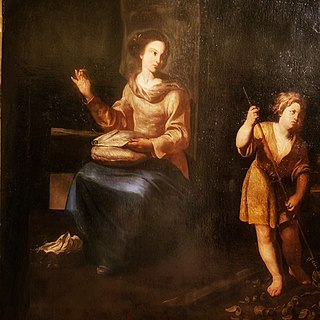
Diana de Rosa, also known as Annella de Rosa or Annella di Massimo, was a seventeenth-century Neapolitan painter.
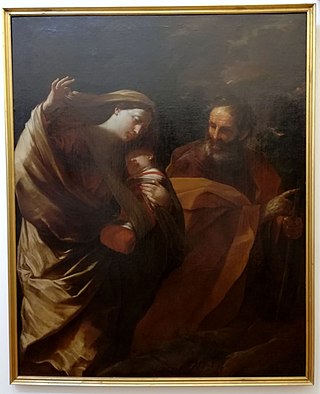
The Flight into Egypt is a c. 1622 oil on canvas painting by Guido Reni in the Girolamini, Naples in Naples.
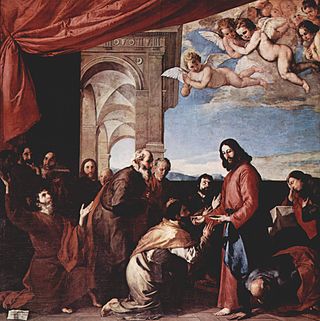
The Last Supper or The Communion of the Apostles is a 1651 oil on canvas painting by Jusepe de Ribera, still in the choir of the Certosa di San Martino in Naples, for which it was commissioned.
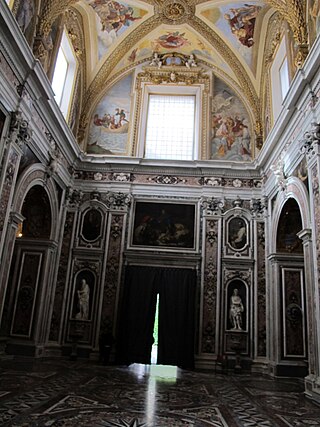
Prophets and Patriarchs is a series of fourteen oil on canvas paintings produced between 1638 and 1643 by Jusepe de Ribera along the nave walls of the church of the Certosa di San Martino in Naples, where they still hang. Moses and Elijah hang behind the west facade, whilst the rest hang under the arches of the side chapels.



















